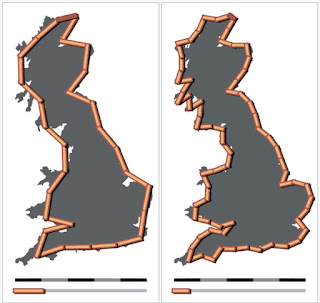You can think of it as a matter of scale. Just for fun, consider the 'coastline paradox.'
If you measure the coast of Britain with a mile-long measuring stick, the result will differ vastly from the result with a ruler. This is because as you look closer and closer, the amount of detail, and thus the length, move in the direction of infinity. Compare the view from an airplane to what you see when strolling along a beach that wiggles in and out of coves and gulches and rock falls. It's a question of measurement scale.
I like setting up my Ram and Capri camper in a spot with few people and settling in for several days, giving myself time to explore the area thoroughly. (The second photo below is a detail of the first.) I enjoy noticing, for instance, that the erosion patterns in soft mudstone right in front of me resemble those on the sides of mesas and mountains far distant. I also get a kick out of imagining these small formations as cliff dwellings. I sat there that afternoon speculating that the background harder sandstone this clung to had, in an earlier era, been entirely filled with mud, and these were the last remnants, soon to melt away entirely. Areas get filled and emptied, filled and emptied. Geologic processes offer a deeper a sense of time.
There are delights in taking time to contemplate the grains in sandstone...
...the subtle detail in the corroding paint of old rusting cars...
...the secrets hidden in a flower's center...
...and to look closely enough to spy two tiny blossoms having a sweet flirtation.
After a few days, moving on to another spot perhaps only a mile away, can offer an entirely new range of delights and discoveries. As John Burroughs (the 19th century naturalist) said, "To learn something new, take the path that you took yesterday."








No comments:
Post a Comment